Introduction
Robotic Process Automation (RPA) is revolutionizing the way businesses operate by automating repetitive tasks and enhancing operational efficiency. RPA utilizes software robots, or ‘bots,’ to mimic human interactions with digital systems, performing functions such as data manipulation, report generation, and transaction processing. This technology significantly improves operational efficiency by reducing error rates, increasing throughput, and providing rapid and consistent customer service interactions.
To successfully implement RPA, organizations need to assess their internal processes, identify automation opportunities, and estimate integration costs. The transformative impact of RPA is widely acknowledged, with professionals in the field recognizing its growth potential and learning opportunities. As advancements in RPA technology continue, the prospects for business efficiency and innovation are substantial.
RPA will play a pivotal role in shaping the way organizations operate and embracing this wave of digital transformation is crucial.
What is RPA and How Does it Work?
Robotic Process Automation (RPA) stands at the forefront of business modernization, enabling the automation of repetitive, rule-bound tasks through software robots, or ‘bots’. These bots are designed to mimic human interactions with digital systems, facilitating a plethora of functions such as data manipulation, automated report generation, and transaction processing. By interacting with user interfaces of existing applications, RPA bots can navigate through systems, input data, and perform complex computations with ease and precision.
The incorporation of RPA into business operations can greatly improve operational efficiency. For instance, bots are capable of extracting and processing data across disparate systems without the need for manual intervention, thereby reducing error rates and increasing throughput. They can also handle customer service interactions, providing rapid and consistent responses, which helps in building customer loyalty and satisfaction.
To guarantee the smooth integration of RPA, organizations must carefully evaluate their internal procedures to identify which ones can be efficiently automated. This includes analyzing the inefficiencies that RPA can address and estimating the integration costs and time required. For example, within the healthcare sector, the digital assurance process is critical. As part of the initial assessment, a request form is submitted, and the Digital Service Team conducts a rigorous evaluation to ensure the proposed digital technology is secure, appropriate, and compliant with standards. It’s also essential to identify any existing solutions within the organization that may overlap with the new technology.
The transformative impact of RPA has been widely acknowledged, with professionals in the field acknowledging the growth potential and learning opportunities. According to a report, the majority of AI automation platform users, including those from the UiPath Community, express satisfaction with their roles and see a promising future in automation. This sentiment is shared across the industry, from seasoned experts to students aspiring to join the workforce.
With the continuous advancements in RPA technology, the prospects for business efficiency and innovation are substantial. As we look to the future, it’s evident that RPA will play a pivotal role in shaping the way organizations operate, highlighting the importance of embracing this wave of digital transformation.
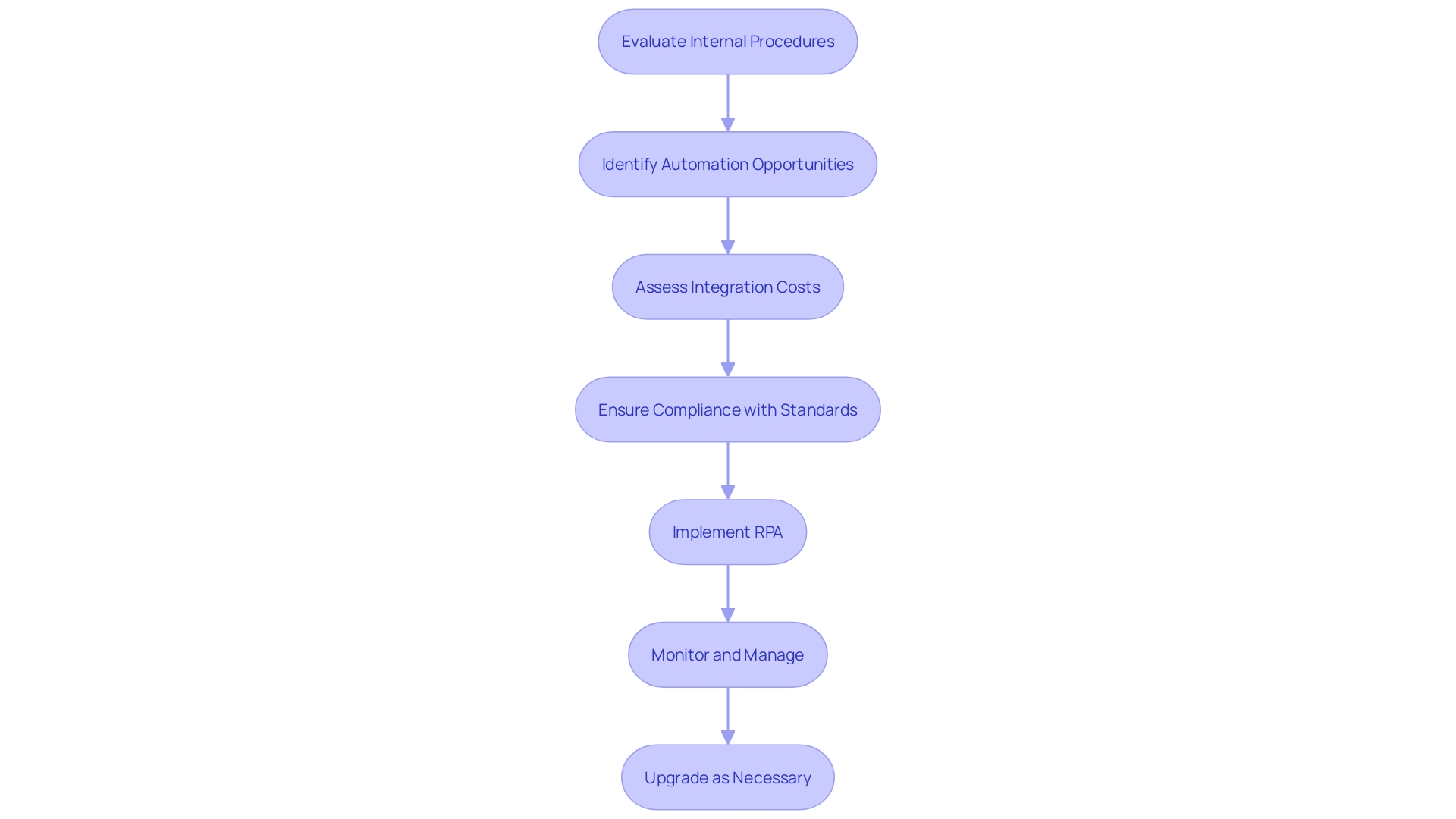
Key Benefits of RPA
Robotic Process Automation (RPA) transforms businesses by dramatically enhancing their operational efficiency. By automating mundane, repetitive activities, RPA frees up the workforce to engage in higher-value endeavors. This change not only enhances efficiency but also decreases the chance of human mistakes in activities like data input, resulting in improved precision in business operations.
Furthermore, RPA’s flexibility is a game-changer for business scalability. It allows for swift adjustments in automation levels to suit fluctuating business demands. For instance, Delivery Hero leveraged RPA to address the high volume of employee account lockouts, which previously resulted in significant downtime. By automating the account recovery process, the company reduced the time wasted and increased operational continuity.
Compliance and auditability are also enhanced through RPA, as it meticulously logs every action it performs. This detailed recording of operations promotes transparency and simplifies audits, as seen at St. James Winery, which capitalized on RPA to ensure consistent quality control, reinforcing its reputation as a top winery in the country.
Moreover, the integration of RPA and Artificial Intelligence (AI) leads to what is known as Intelligent Automation (IA). This combination extends the capabilities of RPA by adding layers of cognitive processing, allowing businesses to tackle more complex tasks.
In the wider framework of business modernization, it’s crucial to acknowledge that mechanization is not a set-and-forget solution. Ongoing monitoring and management are crucial for maintaining system efficacy. The future of business is in creating a collaborative ecosystem where humans and digital workforces enhance each other’s strengths, as advocated by thought leaders in technology and manufacturing.
For businesses considering RPA, it’s crucial to meticulously determine which manual operations to automate and evaluate the linked time and cost for integration. Beginning with smaller assignments, observing outcomes, and gaining knowledge from each project are crucial stages toward achieving success in the process of automating.
To summarize, RPA provides substantial advantages in terms of efficiency, accuracy, scalability, and compliance, but it’s the strategic fusion with AI that unleashes the complete potential of business automation.
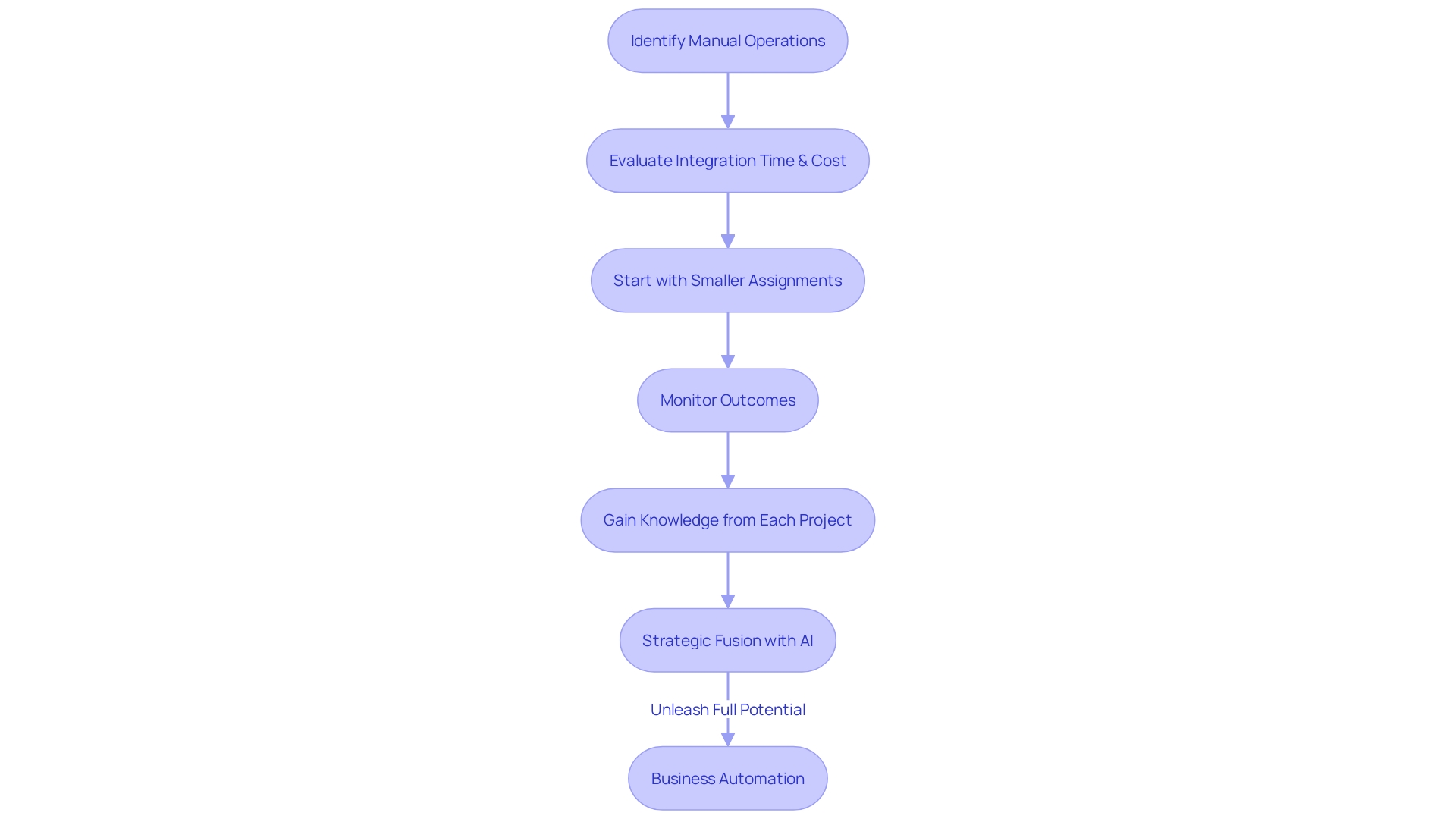
Industry Applications of RPA
Robotic Process Automation (RPA) has been adopted across various industries, leading to significant improvements in business process efficiency. For instance, in the banking and finance sector, institutions leverage RPA to streamline customer onboarding, account reconciliation, fraud detection, and compliance reporting. With the digital transformation of the banking industry, driven by consumer behavior and technological innovation, there is a heightened emphasis on security and compliance. Companies like M&T Bank have addressed these challenges by setting high standards for software quality, including establishing Clean Code standards across the organization to maintain efficient, secure software systems.
In the healthcare sector, RPA plays a critical role in managing patient data, processing insurance claims, scheduling appointments, and handling billing procedures. However, the reliance on outdated legacy systems poses a significant security threat. As reported by a 2022 HIMSS survey, approximately 73% of healthcare organizations continue to use such systems, which often lack the necessary updates and support to safeguard against security breaches.
The manufacturing industry benefits from RPA by automating inventory management, order processing, supply chain operations, and quality control activities. This process allows manufacturers to enhance productivity and decrease the time spent on manual, repetitive tasks.
Retail businesses are also utilizing RPA for inventory tracking, order fulfillment, and enhancing customer support services. Automation in retail not only optimizes operations but also provides a more personalized shopping experience for customers.
To successfully implement RPA, leaders must thoroughly evaluate the benefits and challenges of modernization. It is essential to determine which manual procedures are ready for mechanization and to evaluate the inefficiencies that RPA can tackle. Additionally, understanding the integration time and costs, as well as the potential ROI, are fundamental to making informed decisions about adopting RPA technologies.
As organizations strive for digital transformation, adopting intelligent mechanization, which merges RPA with AI, becomes essential for enhancing operations and formulating more strategic choices. Commencing with the process of automating minor tasks and progressively transitioning to more intricate workflows can establish a solid basis for wider-scale initiatives.
In summary, RPA is a transformative tool for industries looking to enhance operational efficiency, security, and compliance. By meticulously choosing procedures for mechanization and employing a systematic approach, organizations can unleash the complete potential of intelligent mechanization.
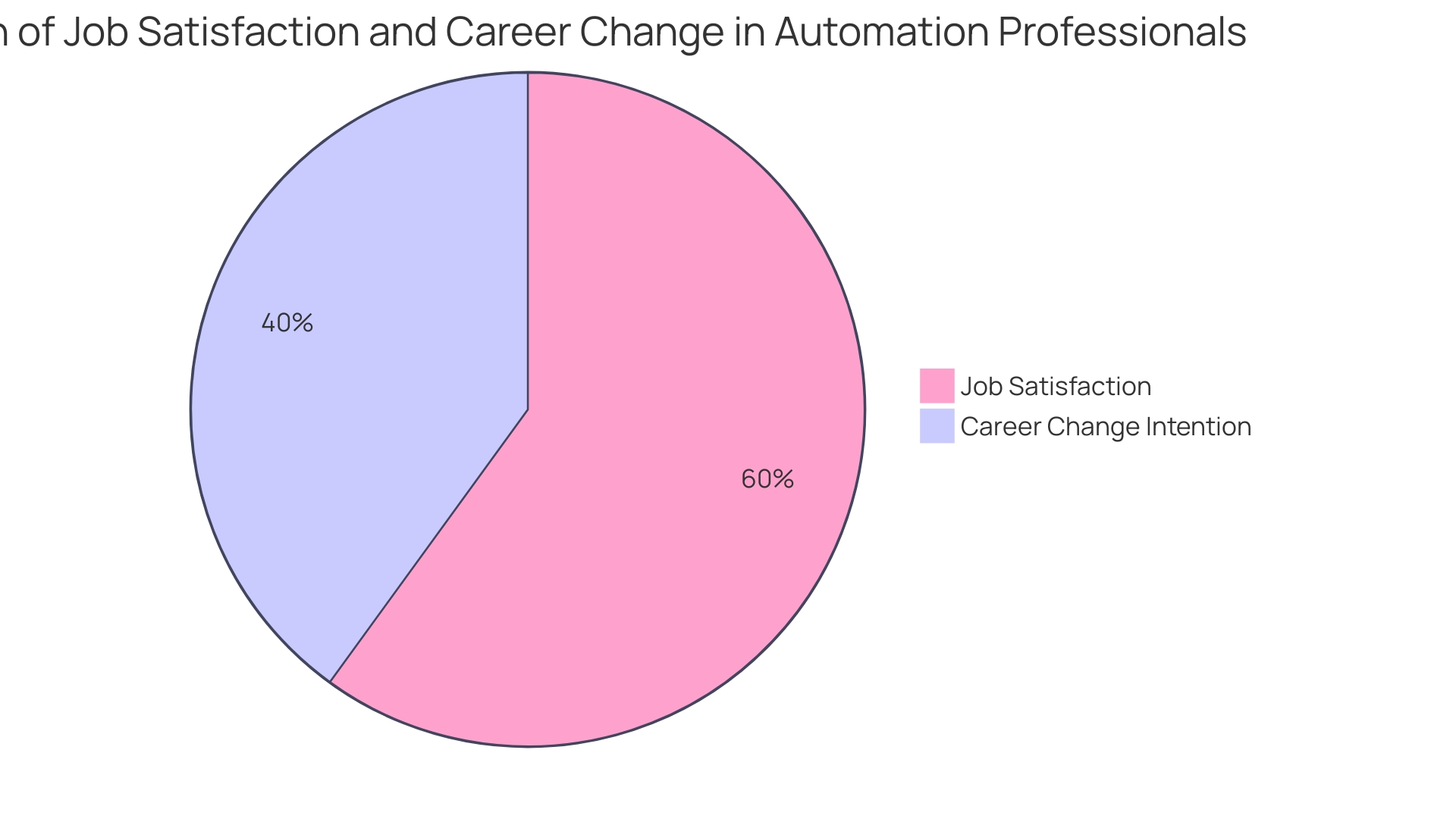
Difference Between RPA and AI
RPA (Robotic Process Automation) and AI (Artificial Intelligence) are both transformative forces in the realm of automation, but they serve distinct functions. RPA excels in automating routine, rule-based activities using software bots, which act as virtual workers carrying out pre-defined processes. This technology is especially skilled in managing structured assignments where predictability is crucial. Conversely, AI is the powerhouse behind intelligent systems capable of tasks that require cognitive skills, such as understanding language, recognizing images, and making informed decisions. These intelligent systems are designed to handle unstructured data and adapt to complex situations that are not as straightforward as those RPA handles.
The choice between these two technologies depends on a comprehensive comprehension of the procedures within an organization. Leaders must consider questions such as which manual tasks are suitable for mechanization and what are the inefficiencies that can be eliminated through such modernization. Evaluating the duration and expenses for RPA integration is vital for every procedure identified for mechanization.
A striking example comes from the healthcare sector, where adopting new digital technologies undergoes rigorous assessment. A clinician or department submits a request form, which then undergoes a ‘digital-assurance process’ to ensure the technology is secure, appropriate, and compliant. This evaluation also checks for redundancy to avoid duplication of existing technologies.
Leaders in operations must be aware of the requirement for such systematic evaluations before implementing technological advancements. It is not just about choosing between RPA and AI, but also about understanding the specific applications and benefits that each can bring to the table. For example, Ai’s potential is being utilized to transform industries with applications like predictive analytics in healthcare and customer service chatbots, suggesting a wider range of opportunities than RPA’s task-specific operations.
Ultimately, the knowledge of what RPA and AI can individually offer, paired with a strategic approach to assessing technological needs, can lead to significant enhancements in operational efficiency. The choice should be influenced by an assessment of the assignments in progress, their intricacy, and the intended results to guarantee the optimal execution of technological advancements.
RPA vs. Business Process Automation (BPA)
Robotic Process Automation (RPA) and Business Process Automation (BPA) represent distinct strategies within the sphere of organizational efficiency, each with their particular scope and application. RPA specializes in the automation of discrete, repetitive activities that follow clear-cut rules, thereby excelling in environments where precision and consistency are paramount. On the other hand, BPA offers a holistic method, aiming to automate end-to-end business procedures which may involve intricate decision-making, human interactions, and integration with multiple systems.
While RPA is adept at tasks like data entry and transaction processing, BPA takes on a systemic perspective, optimizing the workflow to enhance the overall effectiveness and efficiency of business operations. The decision between RPA and BPA should be guided by a comprehensive comprehension of the operational procedures, identification of inefficiencies, and a distinct vision of the mechanization objectives. Incorporating RPA, for example, necessitates evaluating the time and cost consequences for each process earmarked for mechanization.
With the advancement of automated technology, companies can now leverage the capabilities of software bots to carry out workflows across multiple applications, optimizing operations and liberating human resources for higher-level responsibilities. Choosing the appropriate system for streamlining processes, whether it’s a specialized DevOps platform or a flexible tool for various scenarios, depends on the intricacy of the tasks and the users involved.
Automation, as a concept, has roots stretching back millennia, with early inventions like water wheels and steam engines paving the way for today’s advanced automated systems, including AI. Despite this historical progression, mechanization has never been a ‘set-and-forget’ solution; it demands ongoing oversight and collaboration to ensure optimal performance. As we envision the future, the merging of RPA and AI is set to redefine the terrain of intelligent technology, empowering businesses to enhance efficiency, refine operations, and make more discerning judgments, ultimately propelling digital transformation.
Steps to Implement RPA
Embarking on the journey of Robotic Process Automation (RPA) involves a strategic approach to streamline operations. To begin the process of streamlining operations, identifying which processes are well-suited for mechanization is crucial. Usually, these activities are repetitive, rule-governed, and notably laborious. Once identifying these activities, it is essential to evaluate their potential for mechanization, considering the complexities, compatibility with current systems, and the expected advantages.
Once suitable processes are selected, designing the automation framework is the next step. This requires carefully mapping out workflows, actions, and the necessary inputs for each job. Following the design phase, it’s time to bring the bots to life. These software robots are crafted to execute the automated tasks and are rigorously tested to ensure flawless operation.
Deploying these bots into a live environment marks a significant milestone, but the journey doesn’t end there. Continuous monitoring is essential to refine their performance and to make data-driven improvements. With the initial achievements, organizations can then contemplate extending their RPA initiatives to cover additional procedures, thereby amplifying the advantages of mechanization throughout the enterprise.
As highlighted by industry experts, automation has always been a part of business innovation, serving to bolster efficiency and productivity. However, it demands ongoing human oversight to maintain and enhance its performance. In the contemporary setting, the merger of RPA and Artificial Intelligence (AI) is revolutionizing how companies accomplish their digital transformation objectives, facilitating smarter procedures and more strategic decision-making.
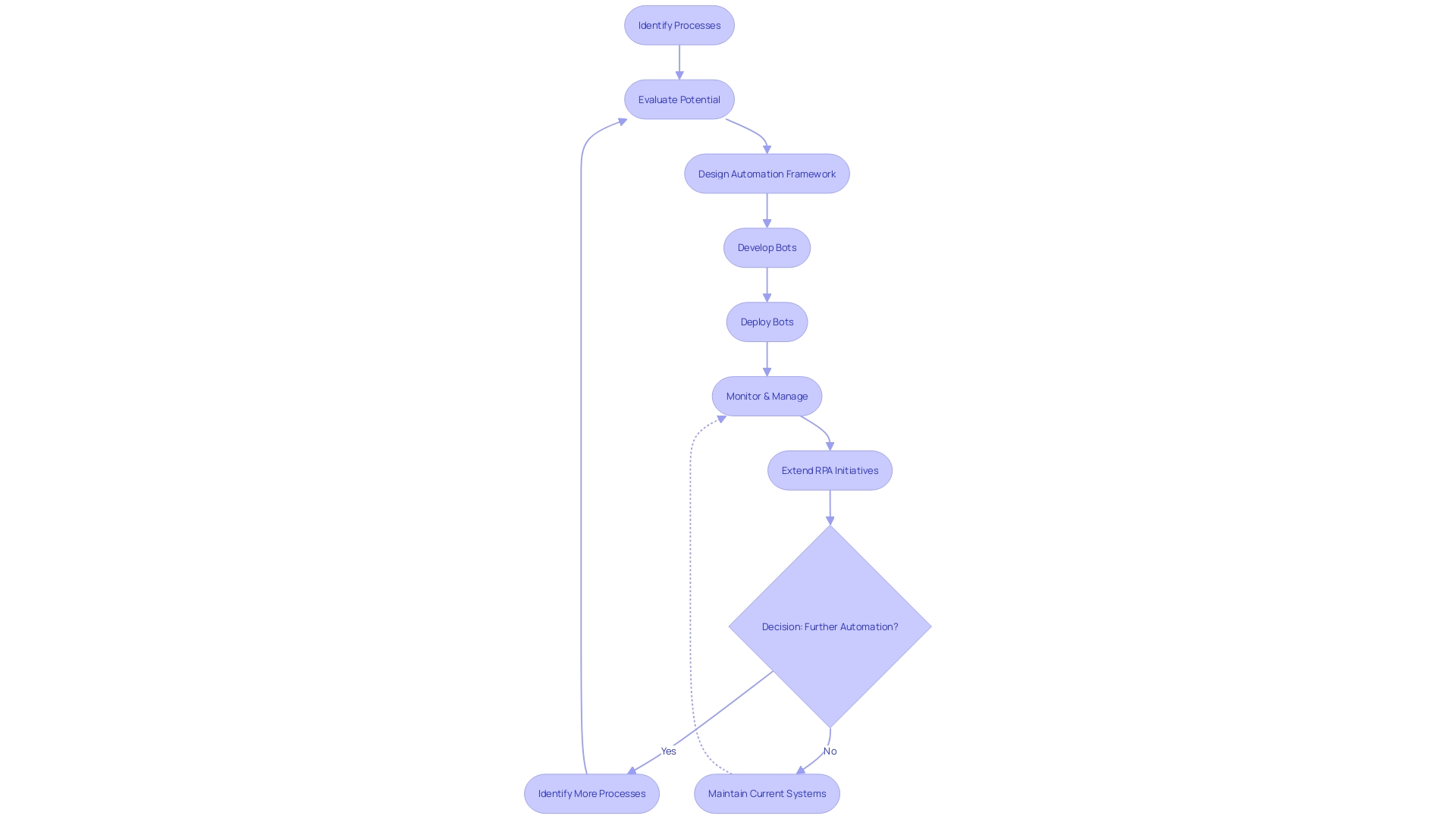
Common Use Cases for RPA
Robotic Process Automation (RPA) is transforming the way industries function by automating routine activities. Here are some impactful applications of RPA that are enhancing productivity across various sectors:
- Data Entry and Validation: RPA bots excel at transferring data between systems, ensuring both speed and accuracy. This reduces the manual effort and minimizes errors associated with human data entry.
- Report Generation: Compiling data from several sources into structured reports is a time-consuming task. RPA streamlines this by automating data extraction and report assembly.
- Invoice Processing: Processing invoices involves extracting key details and updating systems—a perfect task for RPA, which does this with precision and without fatigue.
- Customer Support: RPA aids in managing customer inquiries by providing automated responses to basic questions, allowing customer service representatives to focus on more complex issues.
- Order Handling: Starting from the time an order is placed until it is completed, RPA can automate the complete chain, thereby improving efficiency and reducing the possibility of mistake.
To optimize the advantages of RPA, it is essential to examine and identify particular manual procedures that are ready for automation. Consider the inefficiencies that RPA can address, and evaluate the time and cost implications for integrating RPA software. Begin with procedures that are done by hand, repetitive, and expensive, and strive for immediate successes with activities that are uncomplicated yet generate substantial returns on investment.
As you embark on this journey, remember to map out the processes, pinpoint stakeholders, and assess the systems involved, such as inventory management and online shop software. Starting automation with smaller activities allows for gradual adjustment, and monitoring outcomes ensures that goals are accomplished while providing valuable insights for future projects.
Embracing RPA means stepping into a transformative era where bots can seamlessly execute workflows, freeing up human workers to engage in more strategic tasks. As the synergy between RPA and artificial intelligence (AI) grows, businesses are poised to make more informed decisions, improve processes, and ultimately, realize digital transformation.
Future of RPA: Transition to Intelligent Automation
Robotic Process Automation (RPA) is evolving, poised to transform into intelligent operation. By incorporating Artificial Intelligence (AI) technologies, RPA surpasses its conventional limits of automating simple, rule-based activities. Intelligent merging combines RPA with advanced AI capabilities, including natural language processing, machine learning, and predictive analytics, enabling the mechanization of tasks that require the processing of unstructured data or complex decision-making. This synergy facilitates learning from patterns and making data-driven predictions, thereby enhancing the level of efficiency and productivity that businesses can achieve. As digital transformation progresses through its stagesâdigitization, digitalization, and ultimately, digital transformationâintelligent technology stands as a pivotal technology in reshaping operational models. It empowers organizations to not only digitize information but also to optimize and innovate processes. This is apparent as companies use IoT to link ‘things’ to the internet for data sharing, and as AI drives mechanization beyond monotonous jobs, as emphasized by SS&C Blue Prism’s document mechanization.
Embracing this advancement, small businesses can leverage RPA to fortify customer satisfaction, swiftly responding to inquiries with precision. Scaling operations becomes less daunting as intelligent technology aids in managing growth challenges. For companies embarking on this journey, a phased approach is recommended: initiating with simpler tasks, progressing to complex workflows, and meticulously documenting outcomes. This structured approach ensures that the transformative potential of intelligent technology is fully harnessed, improving processes and enabling more informed business decisions.
The convergence of next-generation technologies such as IoT, 5G, and AI with RPA signals the dissolution of traditional categories, birthing new technological families. This transformation is propelled by requests for sustainability, efficiency, and fair consumer experiences, and is shaping the landscape of automated processes. As businesses adopt AI, it’s crucial to consider data preparedness, the synergy of human talent with digital assistants, IT opportunities, and investment strategies. An 11-point action guide can serve as a blueprint for optimizing intelligent processes, ensuring that enterprises can navigate the journey towards digital transformation successfully.
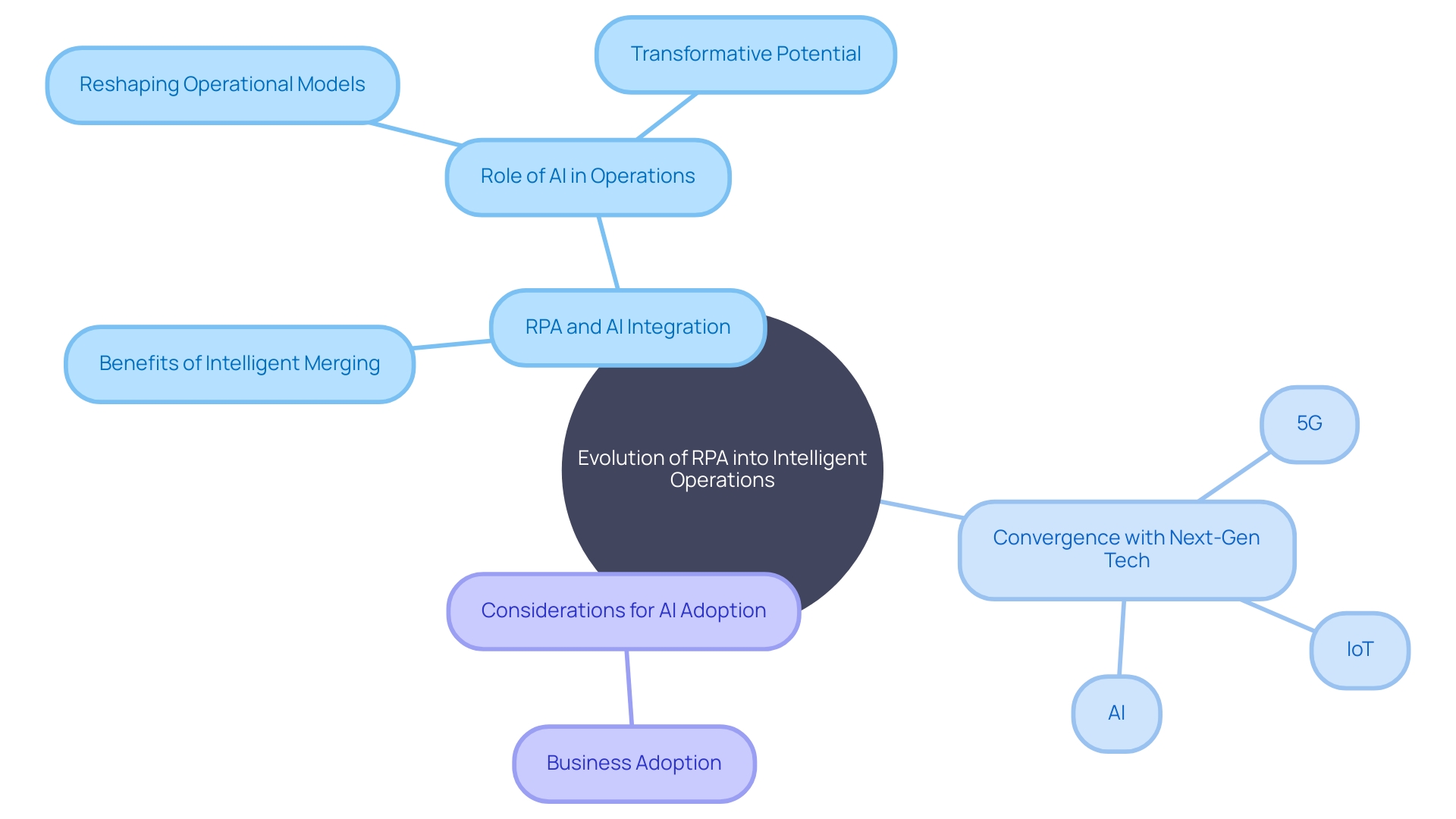
Best Practices for RPA Implementation
Robotic Process Automation (RPA) has become a game-changer in the way businesses operate. To ensure a successful RPA implementation, certain best practices must be observed. It begins with carefully identifying which manual processes are ready for mechanization and comprehending their current inefficiencies. A pilot project serves as an ideal launchpad, providing a clear picture of the potential challenges and benefits, thereby paving the way for a calibrated scale-up of the mechanization efforts.
Involvement of stakeholders is another cornerstone of RPA best practices. Business users and subject matter experts offer invaluable insights, helping to identify opportunities that align with business objectives and facilitate smoother adoption. This collaborative approach was demonstrated by the NHS trust’s ‘digital-assurance mechanism,’ ensuring new technologies met rigorous standards of security and compliance before they were adopted.
Security and compliance are not to be overlooked, as they are critical to protecting sensitive data and meeting regulatory obligations. Incorporating robust security measures such as user access controls, encryption, and detailed audit trails is imperative to maintain trust and integrity within automated systems.
An ongoing commitment to monitoring and optimization is also crucial. As the CTO and Co-Founder of Reveille Software reminds us, mechanization is never a ‘set it and forget it’ solution. Continuous performance monitoring and iterative improvements ensure that automated processes evolve in tandem with changing business needs, thereby sustaining efficiency and productivity gains.
By weaving together these best practices—starting small, engaging stakeholders, ensuring security and compliance, and continuously optimizing—organizations can harness the full potential of RPA, achieving not only immediate operational improvements but also long-term automation success.
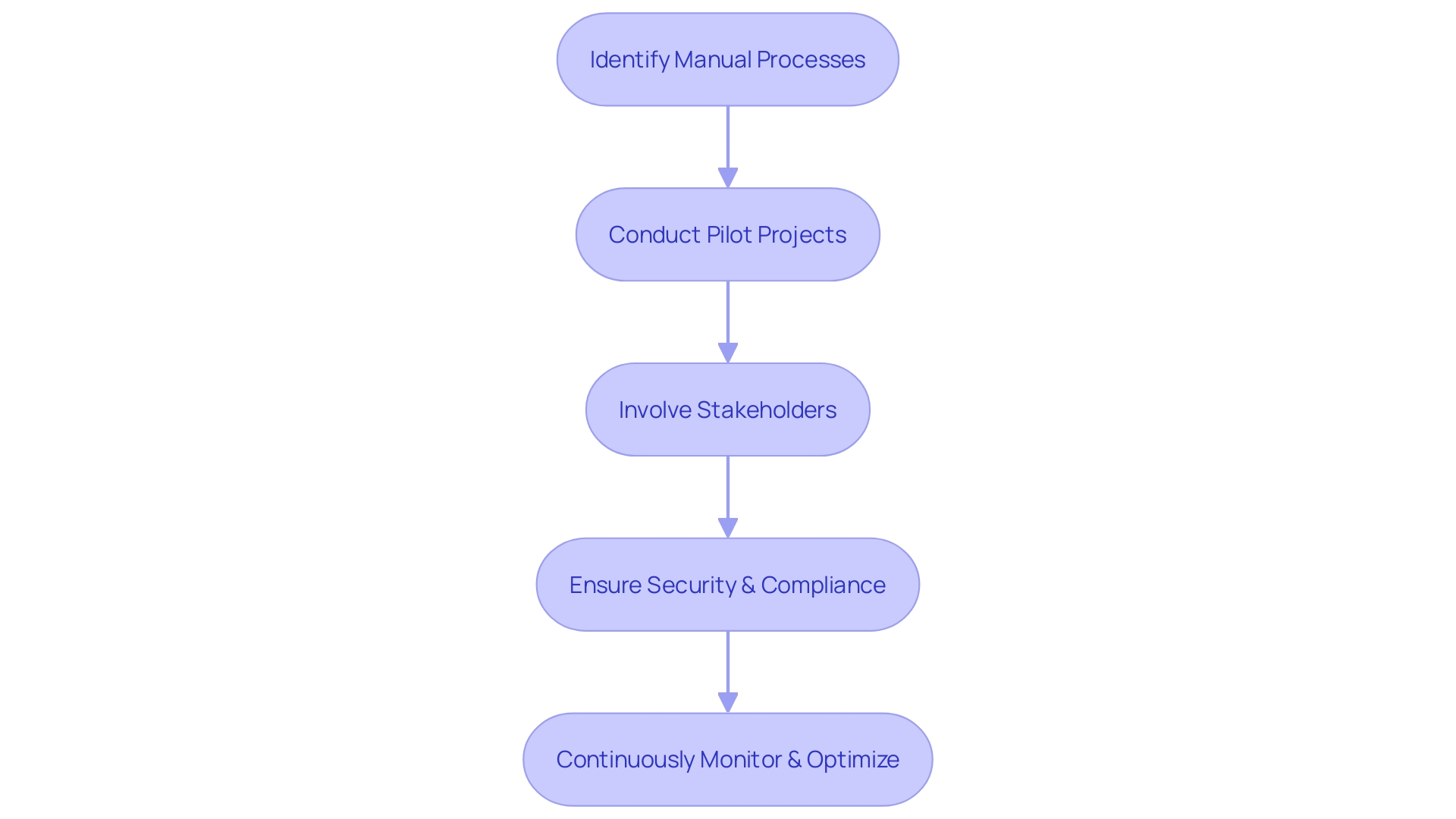
Conclusion
Robotic Process Automation (RPA) is revolutionizing businesses by automating tasks, improving efficiency, and providing consistent customer service. To successfully implement RPA, organizations must assess processes, identify automation opportunities, and estimate integration costs. Starting with smaller tasks and monitoring results are key to achieving quick wins and learning from each project.
RPA offers significant benefits, including increased efficiency, accuracy, scalability, and compliance. It frees up the workforce for higher-value activities, reduces human error, and provides flexibility to adjust automation levels based on business demands. RPA streamlines processes in various industries, enhancing operational efficiency, security, and compliance.
Implementing RPA involves a strategic approach, including identifying processes for automation, designing the framework, deploying bots, and continuous monitoring. Ongoing human oversight and the integration of RPA and AI are vital for successful automation and achieving digital transformation.
Following best practices, such as identifying automation opportunities, involving stakeholders, ensuring security and compliance, and continuous monitoring, can lead to immediate improvements and long-term success.
As RPA technology advances, its prospects for business efficiency and innovation are substantial. Embracing RPA and intelligent automation will shape the way organizations operate and drive digital transformation. By leveraging the capabilities of RPA and integrating AI, businesses can unlock the full potential of automation, making more informed decisions and achieving their operational objectives.

